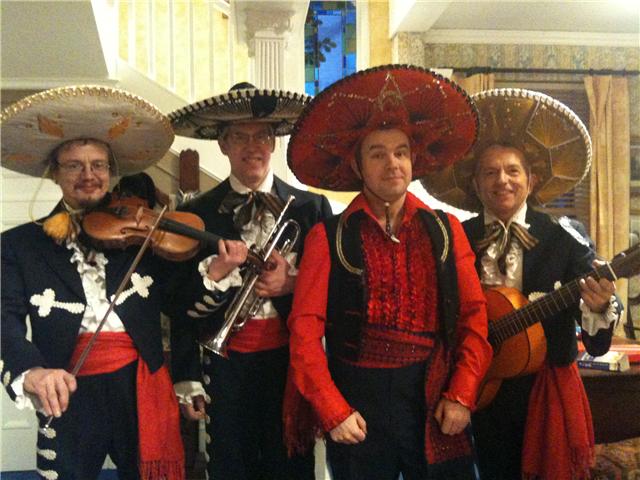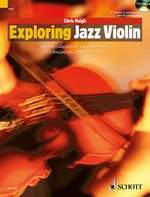
MENU TO FIDDLE STYLES:
Mexican fiddle
If there is one symbol of Mexico more enduring than tequila, the fiesta and the mustachioed bandito, it must surely be the Mariachi musicians, dressed in the outrageous finery of their sombreros and Charro suits, playing and singing endless songs of love and passion.
Mariachi Cobre
Mariachi fiddle
Mariachi bands include anything from two to a small army of violinists, often classically trained and armed with a huge repertoire and impressive technique. Playing usually in the open air (perhaps that's why we don't see many of them in Britain!), and competing with an unrestrained trumpet section, the violinists need a powerful tone and strong vibrato. They usually play harmony with one another, with the trumpets doing counter melodies. Grace notes are used extensively, and pizzicato is very common.
The roots of mariachi lie deep in Mexico's own history, the name probably deriving from the Coca Indian word for musician, in use at the time of the Spanish conquest in 1529. The Indians, who already had their own 5-note musical tradition using drums, flutes and whistles, were taught European music by the Spanish friars as part of the process of conversion to Catholicism. They were given harps, violins and guitars, and these rapidly became integrated into musical life both religious and secular.
By the late 1700's the Son had begun to evolve, a song form using topical or satirical rhyming couplets, with the violin usually leading the melody. This gradually took on the mantle of a national musical idiom, incorporating elements of Indian, Spanish and Negro culture, and during the war for independence in 1810-21 it became a symbol for struggle, freedom and national pride.Mariachi Vargas
The first organised groups began around the middle of the 19th Century; in 1850 Amado Vargas started a band with two violins, harp and guitarra de golpe (a small 5-stringed guitar). His son Gaspar took charge in 1898, calling the group Mariachi Vargas de Tecalitlan, and this was to prove the model and inspiration for all subsequent mariachi groups. Around the turn of the century mariachi arrived in Mexico City, and thrived with the introduction of radio in the 1920's. The vihuela (a 5-stringed guitar) was added to the standard line-up, along with the trumpets which are now fundamental to the mariachi sound..More violins were added to balance the trumpets.
The true golden age of mariachi arrived in the 40's and 50's with the arrival of the motion picture. Mariachi Vargas alone appeared in over 200 films. By now the increasing sophistication of the music was matched by the magnificently overstated costumes. These charro (Mexican cowboy) suits consist of ankle boots, tight trousers with buttons down the side, a short jacket and a large bowtie, all covered with silver spangles and topped off with a huge sombrero. Not an outfit for the fainthearted!
Mariachi Vargas
The modern mariachi band typically consists of at least 8 players; 2 trumpets, 3 violins, vihuela, guitarron (a type of acoustic bass guitar with a huge body and short neck), and possibly a harp or guitar de golpe. Bands have a large and wide-ranging repertoire, reflecting the diversity of social situations at which they are called to perform.
The Son
The most important category of tune remains the Son Jalisciense (from Jalisco). These have a jaunty rhythm,typically alternating between 6/8 and 3/4 time. One of the best known is La Negra; others include El Gusto and La Vaquilla. Different regional forms include the Son Jaracho ( from Veracruz) with songs such as El Cascabel and La Bamba, (popularised by Ritchie Valens), and Son Abejeno, rhythmically complex songs from the lowlands such as El Cuatro and Las Olas. There is a form of dance known as the Jarabe which uses a string of sones; the best known of these is the Mexican Hat Dance (Jarabe Tapatio), so overplayed that it could be considered the Mexican equivalent of Danny Boy.
The Son Huasteco from South East Mexico is also known as the Huapango, with songs like Malaguena and Serenata Huasteca played by fiddle-lead trios. Son Arribeno is played by four-piece bands with two fiddles, a huapanguera (large-bodied guitar) and a singer/poet. They appear in a Topada competition at weddings or fiestas; two groups will be seated facing each other on raised benches with the audience in between. They will take it in turns to play, with the singer improvising verses between the fiddle-led melodies. The singer will start by elaborately praising his opponent, but as the night wears on the musical insults begin to fly as they pour scorn on each other. Audience reaction will finally determine the winner.
Polkas, lively dances in 2/4 time, are important in mariachi music. One of the best known, featuring extensive pizzicato from the violins, is Jesusita En Chihuahua. Waltzes (Vals) include Cielito Lindo, Julio and Sobe las Olas. Pasadobles- what we might think of as Spanish bullfight music- also feature with such tunes as Espana Cani and La Virgen de la Macarena. Rancheras, finally, are nostalgic, romantic songs such as Volver and Por un Amor.
Laura Sobrino
Queen of the mariachi violin
Mariachi Vargas, now well beyond its hundredth birthday, is still regarded as the premier mariachi group. Others include Mariachi Reyes del Aserradero, who concentrate on traditional sones from Jalisco; Mariachi Cobre (currently residing in Disney World, Florida), and Mariachi America de Jesus Rodriguez de Hijar. US based Lauro Sobrino ("Queen of the Mariachi Violin") is one of the few female instrumentalists to have made an impact in mariachi, and is prominent in education and publishing within the genre. A great boost was given to the international profile of mariachi when in 1987 Linda Ronstadt released an album "Canciones de mi Padre" in honour of her Mexican roots, and toured with Mariachi VargasDespite its importance, mariachi is by no means the only fiddling style found in Mexico. Juan Reynoso ("The Paganini of the Hotlands") is a virtuoso fiddler, who, in his late 80's, leads his own band in the traditional style ofTierra Caliente in the southwest of the country. He is accompanied only by guitar and tamborita (a small wooden drum) so that the virtuosity of his playing is displayed far more than if he was a mariachi. Though self-taught, he has an advanced sense of harmony, and uses double stops almost continuously, dancing with great agility up and down the full range of the fiddle
Juan Reynoso
Raweali
Finally, we must mention the fiddling of the native peoples of Mexico. When the Spanish arrived in the 16th Century they brought with them the Rabel, a small 3-stringed violin, and the Indians took to this more eagerly than the authorities had expected. By 1555 it was considered a disruptive influence and was bannedthroughout New Spain. This naturally had the opposite effect intended, and in rural areas native versions of the fiddle continued to thrive and diversify into various regional forms.
The Huichol Indians of west central Mexico have a fiddle of white wood, with two horsehair and two metal strings. This Raweali is used in magical rituals, and legend has it that it came to them direct from Santo Cristo (the Divine Christ), who won a fiddle contest using the instrument. Surely the only known case of the devil not having the best instrument and all the best tunes!_______________________________________________________________________________
Chris Haigh is a fiddle player based in London; he has a large repertoire of bluegrass, old time and Western Swing fiddle tunes, and performs either solo, with a singer/guitarist, with a larger country rock band, or with the barn-dance band QUICKSILVER. He has worked with Leon Hunt's Southern Exposure and The Daily Planet, The Coal Porters, Orange Blossom Sound and the Charlie Boston band. He gives lessons and workshops on jazz and bluegrass fiddle, and has published several fiddle books , including The Fiddle Handbook The Fiddle Handbo.
Here he is with a pretend mariachi band on the set of TV sitcom My Family:



